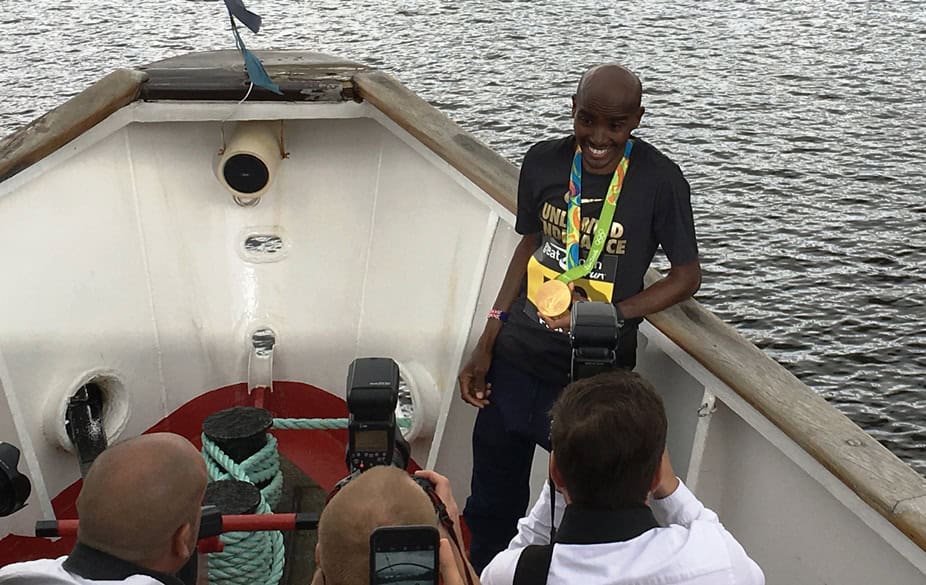By David Monti, @d9monti
(c) 2016 Race Results Weekly, all rights reserved
GATESHEAD, ENGLAND (09-Sep) — Four-time Olympic gold medalist Mo Farah moved through the lobby of the Hilton hotel briskly here this morning, the hood of his Nike sweatshirt pulled over his head. He was on his way to a photo shoot in advance of Sunday’s Great North Run, and he wanted to keep a low profile. That’s become increasingly difficult for a man who has become one of Britain’s most accomplished and famous athletes.
“The reality is, is that what comes with it,” Farah later told reporters about what it’s like to be in the public eye. He continued: “Anybody who does anything has come through a lot.”
Farah, 33, has indeed come through a lot. Eleven years ago he was seen mostly as a good domestic athlete, the training partner of the then-dominant Craig Mottram of Australia. Although Farah quickly developed into Europe’s top distance man, first winning a silver medal at the 2006 European Championships 5000m then the gold at the European Cross Country Championships later that year, he would not achieve true greatness until he joined Alberto Salazar’s Nike-sponsored Oregon Project, a decision he made in 2010.
“I knew something had to change,” Farah said. “It’s changing one or two percent that made the difference.” He added: “Every athlete dreams of becoming Olympic champion. I knew I had to do what they do.”
Moving his family to Portland, Oregon, Farah embraced Salazar’s approach, put in the work, and improved quickly. By 2011, he was seen as a double gold medal threat at the IAAF World Championships, winning the 5000m title and taking second behind Ibrahim Jeilan of Ethiopia in the 10,000m. After that, Farah was unstoppable, winning the world and Olympic 5000m and 10,000m titles in 2012, 2013, 2015 and 2016. Titles, Farah said, is what his legacy is all about. He’s yet to set, or even attempt, a world record.
“I know I gave it my all, and that’s who I am,” Farah said. He continued: “That’s what drives me: I want to make history.”
Here at Sunday’s Great North Run, Europe’s second-largest half-marathon, Farah also hopes to extend that history. He’s competed here the last three years, taking second to Kenenisa Bekele in 2013, then winning in both 2014 and 2015. If he wins on Sunday, he’ll join South Africa’s Hendrick Ramaala, Kenya’s Benson Masya, Scotland’s Liz McColgan and Australia’s Lisa Ondieki as a three-time event champion. The late Masya, who died in 2003, is the event’s only four-time champion, winning in 1991, ’92, ’94 and ’96.
Should Farah lose, it would be an upset. His chief rival is three-time USA Olympian, Dathan Ritzenhein, one of Farah’s former training partners at the Oregon Project. Ritzenhein, who is training for the TCS New York City Marathon in November, has a career best time of 1:00:00, run at the IAAF World Half-Marathon Championships in Birmingham in 2009. Ritzenhein has run the Great North before, finishing third 10 years ago in 1:01:25, and fourth in 2010 in 1:02:35.
The other top-seeded athletes are Abdi Abdirahman (USA), 1:00:29 PB; Emmanuel Bett (KEN), 1:00:08; Chris Thompson (GBR), 1:01:00; and David McNeill (AUS), who will be making his debut at the distance.
Farah said that he realizes that he’s in the final years of his career, and said that he doesn’t recover as quickly. That means he has to choose his races carefully, especially with the IAAF World Championships coming to London next year.
“It’s getting harder (to stay at the top),” Farah admitted. He continued: “You have to be patient and work it out. I’ve learned in life what goes up also comes down.”
